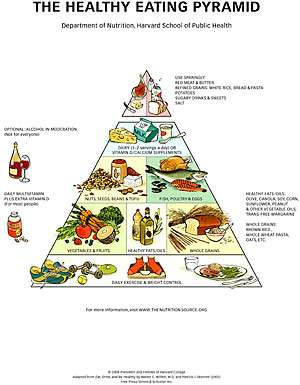New pyramid puts oil, exercise, poultry in their place

The Department of Nutrition at the Harvard School of Public Health (HSPH) has relaunched its Web site, The Nutrition Source (www.thenutritionsource.org/).
One of the highlights of the improved site is a freely downloadable version of the Healthy Eating Pyramid, built by nutrition faculty at the School, which should appeal to educators and health professionals as well as institutions such as schools and hospitals.
Updates to the pyramid include the addition of salt to the “Use Sparingly” section at the top. Also, the pyramid now recommends at least 1,000 IUs of vitamin D for most people.
To make The Nutrition Source more user-friendly, the site now gives readers quick summaries of each nutrition recommendation, so that they can get the “bottom line” on protein, fats, carbs, and other aspects of healthy eating. Each recommendation is accompanied by “5 Quick Tips” for how to put the advice into practice — how to choose high-fiber foods, achieve a healthy weight, stock a healthy kitchen, and other topics. Also, the site is now fully searchable from each page. “There’s a lot of confusion out there about what to eat,” said Sari Kalin, program coordinator for The Nutrition Source. “The Nutrition Source’s new design helps people cut through the confusion and find clear answers to their nutrition questions.”
Other new features of the site include a section of healthy recipes for home cooks from well-known chefs and cookbook authors, including Mollie Katzen, Ming Tsai, and The Culinary Institute of America. The HSPH cafeteria, which features delicious healthy meals, also contributed. In addition, The Nutrition Source has a cleaner, more user-friendly design, and the scientific references have been updated to reflect the latest research in the field.
The Nutrition Source site debuted in 2003 with the goal of providing an independent source of nutrition information based on the latest and best science. “We accept no advertising, so our site is free from any commercial influences,” said Lilian Cheung, editorial director of The Nutrition Source and a lecturer in the Department of Nutrition. “We strive to inform the public with unbiased scientific information on healthy eating that can be incorporated into their daily lives.”
The Healthy Eating Pyramid is a practical guide to maintaining a healthy diet. At its foundation are daily exercise and weight control; as the pyramid rises, it shows that one should eat more foods from the bottom part (whole grains, vegetables, fruits, healthy fats) than the top part (red meat, refined grains, sugary and salty snacks). An important feature of the pyramid is that it focuses on the quality of foods, not the quantity — it doesn’t recommend specific serving sizes, which can vary from person to person. Rather, the pyramid is meant to be an easy-to-understand, flexible guide to how one should eat.
Source: Harvard University




















